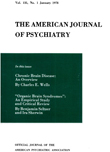Newborn minor physical anomalies and problem behavior at age three
Abstract
The authors followed up 136 three-year-olds who had high or low scores for minor physical anomalies of face, head, hands, and feet at birth. Interviews with parents revealed that high-anomaly infants were somewhat more likely to have problem behaviors at age three; this was particularly true for hyperactive-impulsive behavior for boys. Preschool teachers' ratings of hyperactivity, however, did not show a significant relationship to anomaly score. The results suggest some congenital contributors to behavior disorders of childhood, but the relationship between anomalies and problem behavior is weak and limits clinical usefulness of this measure when used alone for identifying a high-risk population.
Access content
To read the fulltext, please use one of the options below to sign in or purchase access.- Personal login
- Institutional Login
- Sign in via OpenAthens
- Register for access
-
Please login/register if you wish to pair your device and check access availability.
Not a subscriber?
PsychiatryOnline subscription options offer access to the DSM-5 library, books, journals, CME, and patient resources. This all-in-one virtual library provides psychiatrists and mental health professionals with key resources for diagnosis, treatment, research, and professional development.
Need more help? PsychiatryOnline Customer Service may be reached by emailing [email protected] or by calling 800-368-5777 (in the U.S.) or 703-907-7322 (outside the U.S.).



